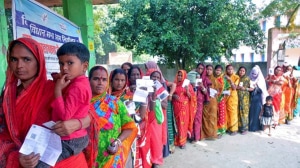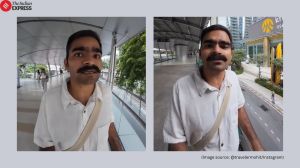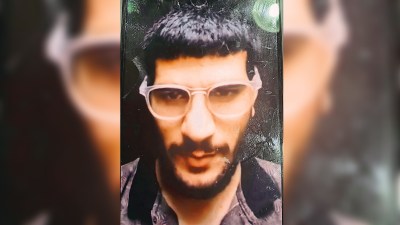Meet the men who brought Vande Bharat trains to life: ‘Why couldn’t we make our own high-speed trains?’
Meet the engineers and designers behind the development of Train 18, India's first indigenously designed and manufactured high-speed train. The team faced several challenges, including limited domestic expertise and resources, but managed to create a world-class train with a top speed of 180 km/hour. The success of Train 18 has boosted India's self-reliance in the railway sector and provided a foundation for future developments in high-speed rail technology.
 (L to R) DP Dash, S Mani, S Srinivas, Subhranshu and Manish Pradhan, the engineers behind Vande Bharat trains
(L to R) DP Dash, S Mani, S Srinivas, Subhranshu and Manish Pradhan, the engineers behind Vande Bharat trains “Indian trains are never white, because in India we have a belief that anything white would look dirty faster,” Manish Pradhan jokes. “So, we decided our train will be all white and it will not look dirty. Look at it now.”
Pradhan was the engineer in charge of furnishings of the first Vande Bharat trains, and a part of the motley group of engineers who designed India’s marquee semi-high speed trainsets at Chennai’s Integral Coach Factory (ICF) in 2018.
It has been four years since the first Vande Bharat was inaugurated by Prime Minister Narendra Modi on February 15, 2019. There are 10 such trains now — all painted in a gleaming white with a bright blue band — and 400 more are on the way.
“We tried red and black, cream and red before zeroing in on the white and blue,” says Shubhranshu, who was the Principal Chief Mechanical Engineer of the unit, heading the team at that time. “We painted it like a luxury car and not a train. It has six coatings of paint and the final one is a transparent coat that wards off dust.”
The Indian Express spoke to the original team of engineers who brought the self-propelled train, that runs 180 kmph, to life from scratch. Like proud parents, they rattle off its achievements and many firsts.
“I saw trains in Europe had retractable footsteps, when doors are opened. I said our train must have this too. Then there’s the continuous window… I said let’s create an effect that looks like it’s one glass continuing in the whole train even though they are separate windows. Now see, everyone likes it,” says S Srinivas, the Chief Design Engineer, Mechanical, of the project, with barely concealed excitement.
Debi Prasad Dash, Chief Design Engineer, Electrical, of the project then, says the CCTV cameras were a nice touch. “I said let’s keep CCTV cameras outside and inside for the driver to see passengers and platforms. Some people were like, kya zaroorat hai… but today you see, footage captured in those cameras identified the boy who was throwing stones at the Vande Bharat in Bengal.”
The man who put them up to the challenge was Sudhanshu Mani, the then General Manager of ICF — the factory set up with Swiss collaboration in 1955 to give the new nation an edge in making its own trains. A year after it was opened, visiting Chinese Premier Chou En Lai toured the facility and wrote in the visitors’ book that he wished Chinese engineers learned from the ICF.
“China used to import trains from all over the world until one day they said, bas ho gaya… then they started making their own high speed trains. I thought to myself, why can’t we?” Mani says.
Mani, an old hand in the Mechanical Engineering service in Railways, retired from ICF in December 2018 and quickly became something of an evangelist of the Vande Bharat story on the internet.
In his now-famous TEDx talk in Hyderabad three years ago, he said that to get the Railway ministry to sanction the project (and the money), he had to fall on the feet of a “top guy”. But Mani never explained why a General Manager would take up the task of making a world-class trainset with just two years to retire.
“No one put me up to it. It was my own angst,” Mani says. “You close your eyes, and only one image of trains in India comes. That image had remained the same for decades. Why couldn’t we alter that?”
Mani was posted as the government’s Railway Adviser in Berlin for three years. The government created the post in the 1980s for seamless transfer of rail technology from Germany to India. The Linke Hoffmann Busche coaches in India were a product of that collaboration.
“India decided to import the LHB coaches from Germany in the early 80s. The order was placed finally in 1986. But it took a decade more for the coaches to actually roll out in India,” Mani says. “By that time, the 1990s, the technology was already two decades old.”
While in Europe, Mani watched closely how railway technology evolved. Movies, magazines the world over would show swanky, high-tech trains—a far cry from what was running in India, he says. “The angst kept getting bigger. It was only in ICF that I was finally in a position to do something about it,” he says.
In April 2017, the Railway Board gave permission to make two trainsets. They had to turn it out by 2018. Because Mani would retire in December 2018. “What if the next General Manager did not share this vision? What if the team is transferred out? So we all said, let’s do it in 18 months,” Mani says.
They called the project Train 18, and the team was formidable: they were seasoned railway engineers all in their 50s, trained in the IITs and a host of other institutions. But time was short.
Dash fondly calls it a “T-20 match”. “We had 20 overs but we had to win it in 18,” he laughs. “And we did.”
One thing that has gone unrecognised in the Vande Bharat story is a little-known policy intervention by the NDA government a few years prior to this. The government granted unprecedented financial powers to General Managers of zones and production units, so that they did not need to refer matters to the ministry often. Mani could get a free hand to steer the project in the direction and pace he wanted using those powers.
“When we realized Indian companies did not make the quality seats we wanted, we went to the best in the world. We straightaway called the best makers of brakes in the world and told them to make better than the best brakes. Government rules do permit a lot of things, but bureaucrats are often scared of using them,” Srinivas says.
Over the next 18 months, endless sessions of filter coffee in the sweltering heat and humidity of Chennai, club gatherings, dinner tables in the ICF, all were dominated by only one conversation—Train 18. That’s why all of them say the credit for the train goes to entire team of ICF as well as Indian Railways.
“Not just officers but around 5,000 workers, including those of the vendors were working day in and day out at the shop floor, round the clock. So, curious family members started trickling into the workshop to see what it was that was keeping the husbands away. That’s something I remember from those days,” he says.
In the four years, life has changed for the team. The trains have run lakhs of kilometers with little trouble save a few minor hiccups, like cattle hits. The design has had changes too.
Mani is a retired railway expert based in Lucknow, now routinely making appearances on social media, TV and lectures. Subhranshu, who was transferred out of ICF to Southern Railway within a week after the first Vande Bharat was inaugurated, now heads the Rail Wheel Plant in Bela, Bihar.
Srinivas now heads the Mechanical Engineering wing in ICF while Dash heads the Electrical Engineering vertical. Pradhan now is the Chief Design Engineer (Mechanical) of the factory. These three are still part of the process of churning out the latest Vande Bharats including the upcoming Sleeper version.
“We try to weave all passenger feedback, negative, positive, into the subsequent coaches,” Srinivas says.
The journey following the first two trainsets (one ran from Delhi to Varansai while the other from Delhi to Katra) has been slow. Various internal processes and rethinking on the trajectory of the production meant the third Vande Bharat arrived around 25 months later. “We could have had 100 Vande Bharats by now,” Shubhranshu says. “But it’s good that the production has picked up speed.”
What, finally, is the legacy of the Vande Bharat story?
Mani says that someday India will make its own high speed trains, even if it needs some handholding from foreign firms.
“We did everything from scratch after hunting for a reference point. Hopefully in the future, the Vande Bharat and its journey will be a roadmap for our engineers,” Dash says.
Manish Pradhan carried a notebook those days that had all the drawings, notes, stray ideas, instructions, jottings of collaborations of 18 months. For him this was the true history of the Vande Bharat. For a few years he used the notebook to show young probationers how the project was created, how it was shaped etc as part of their learning. Once a trainee took it from him to take notes. “And I never got it back,” he laughs. “But I have it all in my memories.”







